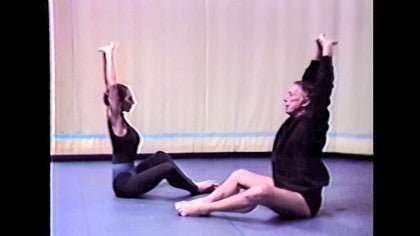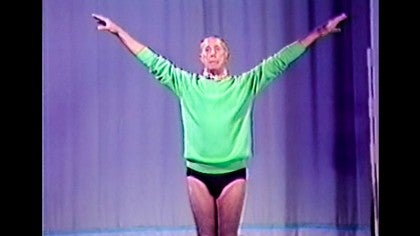Description
About This Video
Transcript
Read Full Transcript
The Fletcher and lineage of the Pilati Smith edge is quite classical. Um, when Ron opened his studio in Los Angeles in 1971, it was after at least two decades of study with Joseph and Clara [inaudible]. Um, his original studio was, was based on what he learned from Joseph and Clara [inaudible]. He did develop several techniques that were based on the original method and he developed those techniques out of a need, especially when he was taking [inaudible] outside of the Palati studio setting. The tagline for Fletcher [inaudible] is evolved from the source and that's exactly what, what the method ends. Um, Brian took the source information from, from Joseph and Clara, and he evolved and in a way that was very organic. Um, but that was always true to the source.
He stayed in touch with Clara Palladio's until her death. And anytime he wanted to, um, change something or, or define it further, for instance, the breath bringing the work to standing, he was always in touch with Clara. Um, asking her permission, explaining why he wanted to make, um, certain changes. And, uh, her response to him was, Ron, you may do this, you're the man to evolve this work, but you must always stay true to the abcs of the method. So Ron was one of the first, um, if not the first to take Pilatos out of a plotting studio setting and teach it in more of a workshop setting and doing so very few people had Polonius equipment at the time. So Ron was forced to be more creative with, with his dissemination of the work. Um, uh, in doing so he developed aspects of the work that were based somewhat on the mat work. Um, he brought the work to standing. He, he developed the Fletcher shall work, the Fletcher Barb work, um, and he took a lot of the pieces from the equipment and he developed them on the floor. And so the pieces have, um, a similar look to perhaps pieces on the reformer, the chair, the Cadillac. But Ron took them and brought them to the floor so that more people could have an experience of the work.
Certain techniques are considered Fletcher techniques. Um, and among those, the most notable would be the Fletcher floor work, the Pletcher tel work and the Fletcher bar work techniques. Um, Ron also developed the Fletcher per Casa Breath, um, and he brought the work to standing and it's called the standing and centering technique. Um, the Fletcher tell work was really developed to bring, um, not only an opening, uh, and a postural stance to the upper body, but also more articulation to the shoulder joint and by stabilizing the shoulders, more articulation to spinal movement. The Barb work likewise was developed to bring more articulation to the lower body. Um, even though it is a dancers technique, Ron approached the bar work very much from a movement perspective and he was the first person to teach Barb work within a Polonius setting. And so now borrower work is taught widely, um, in the United States and around the world. And it's interesting that Ron Fletcher was the first to do that. Um, the Fletcher floor work is, is really a marriage of the plots movement principles. The Polonious mat work with the ground floor work. And so, um, it tends to be more three dimensional.
It's very much about contraction and release. Um, and there's a lot of hip opening in the work. He felt that the mat work, um, was essential and, and all of his teachers are required to perform them at work and teach them at work. Pristinely. Um, and he felt that the, that the floor work was an evolution of that. Um, so the, the Fletcher floor work takes the mat work principles and takes them more into three dimensions, um, and, and is more of an artistic expression of the these principles. Ron is also known for creating what he called variations on themes. And, um, he took, um, pieces that are very classical pieces to the Polonius method and he developed them in a way that he felt made more sense, um, to the body. So he would take pieces of movement that he felt perhaps were being performed with, with too much momentum. He added more breath to them or precision. Um, and he did add some choreographic elements to the, the equipment work, um, that add interest. So perhaps require more thought, more control.
Um, and, and I think make the work, um, more beautiful. So Ron was very much about line and, and beauty and precision, um, not only for the dancer but for the non dancer and, and his, his pieces of movement that he developed really pull that element out of people. And I think that it makes them want to perform the work more from a movement point of view rather than an exercise point of view. The program of study, um, was the, the name of our program was coined by Ron. Um, he did not like the word t, the words teacher training program. He felt that we train animals and we teach people and that that learning Palladio's is really a study. And so he was the one who said, I'd like for my program to be called the program of study. So our comprehensive program is titled Just that, um, uh, we're very clear, um, about teaching the classical, the original Polonius work, separate from the techniques that Ron developed.
So we have the entire syllabus on all pieces of equipment in our comprehensive program. And then we also pull in the different techniques that Ron developed and show how those can be added to a program, how those can enhance the program, and also how those, uh, techniques can help take a program beyond a studio setting. Um, we also have several continuing education courses. Um, Ron was known for his development of work on the Peda Pole, um, on the spine corrector also in the Giga teen tower. Um, and then we have the Fletcher intensive, which takes his three techniques that the towel work, the floor work in the Barb work and teach us those as a Fletcher intensive for teachers from other lineages who want to add an aspect of the Fletcher work into their practice. The title of Ron's book, which is now out of print, but you can probably still find it, um, was everybody is beautiful. And, and he really did believe that there is, um, a, there's an inherent correctness in, in beauty and in, in moving beautifully. Um, it's, it's, um, it's moving from the inside out. It's moving from a very, uh, a place of truth. Truth was an important word to him. Um, and when movement, it comes from the inside out, it doesn't matter what the outside end looks like. Um, so it was very much about the correctness of line, um, about feeling the movement and taking the movement all the way through the body. So not moving in parts, um, but moving the body as a whole, which, which is a beautiful thing in and of itself.
Ron Fletcher really brought a spirit to the work and Ron and body and spirit. Um, and in return to life, Joe Talks about body, mind and spirit, breath and spirit. Um, in some dictionaries mean the same thing. And the, the breath that brought that Ron brought to the work, um, really abused the work with, with spirit. Um, one couldn't take a session with Ron without feeling, um, a certain sense of elevation, certain sense of just, um, joy. And, and he was very much about joy. He was also very much about pulling that last little bit out of you. Um, so he was a huge personality. He was, um, bigger than life and, and yet he was also so loving and so caring as a teacher.
Um, so I think that the breath and the spirit is, is what Ron brought to the work. He brought the work to life, um, in a way that that was very unique and true to, to run. Many people have a chance to experience that through his teachers around the world.





You need to be a subscriber to post a comment.
Please Log In or Create an Account to start your free trial.